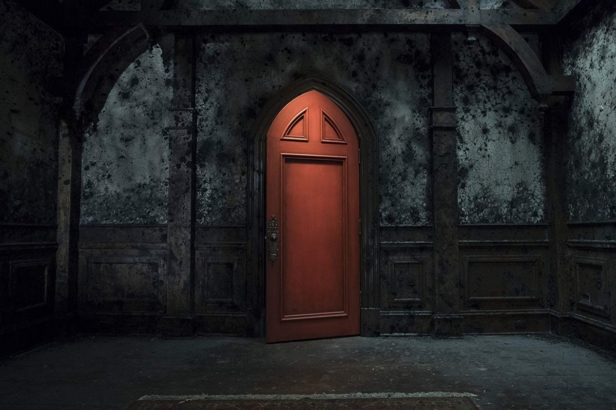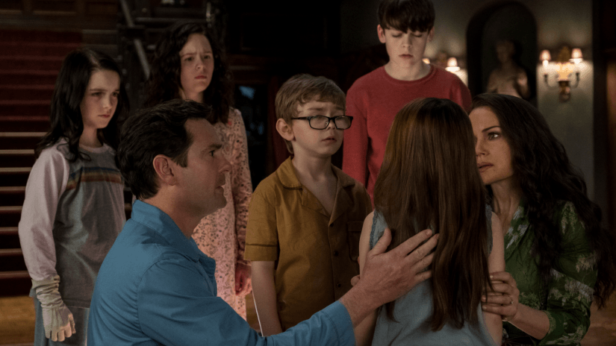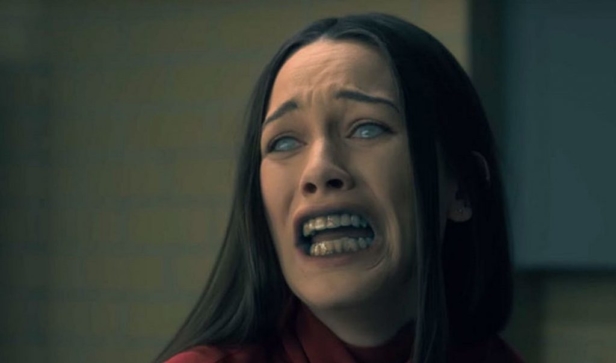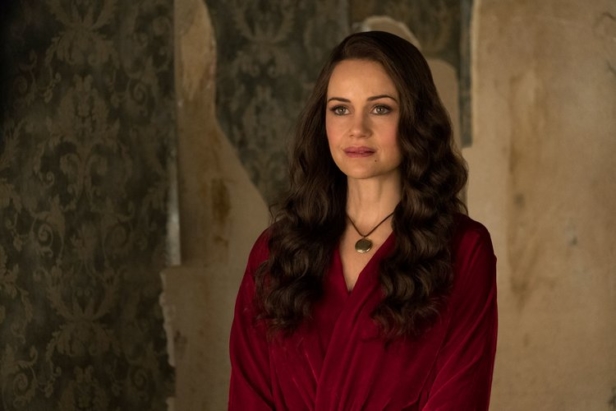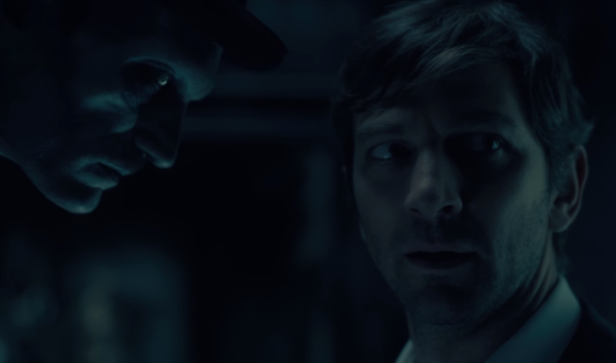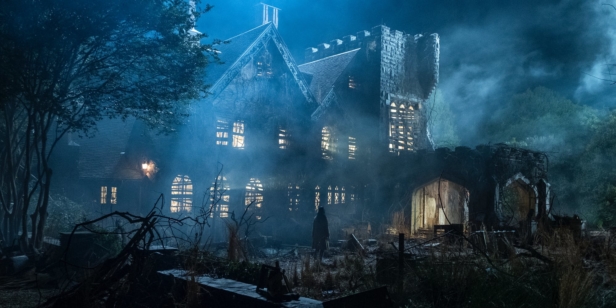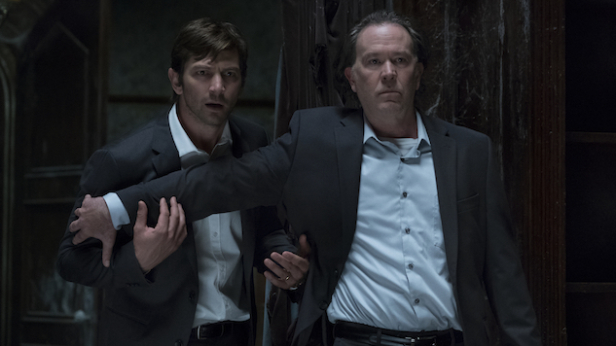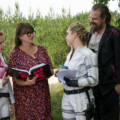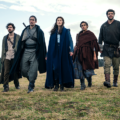Mike Flanagan is one of the most consistently excellent filmmakers working in the horror genre at the moment with Absentia, Oculus, Before I Wake, Ouija: Origin Of Evil and Gerald’s Game, and his latest, a Netflix series based on Shirley Jackson’s classic The Haunting Of Hill House, is right up there with his best.
Rather than re-tell the story of strangers in search of a spirit in Hill House, Flanagan decided to make a show about a family traumatised by their experiences inside the house as children as parents Hugh (Henry Thomas as the younger man, Timothy Hutton in the present) and Olivia (Carla Gugino) work on restoring it before tragedy strikes.
When we meet the characters as adults, they’re all scarred by the memories of what they did (or didn’t) see in Hill House. Steven (Michiel Huisman) has become a successful writer, using their family story for his breakout hit. Shirley (Elizabeth Reaser) runs a funeral home, living with her husband and her sister Theo (Kate Siegel), who works as a child psychologist. The two youngest, twins Nell (Victoria Pedretti) and Luke (Oliver Jackson-Cohen), are the most clearly traumatised as the former battles with mental health and the latter with drug addiction.The series jumps between the Crains’ arrival and the events that followed, and what happens when something shocking pulls them back together as adults and forces them back inside the home of their childhood nightmares…
How did you get involved with Hill House? Did they come to you?
Yeah, Amblin television had the rights, and I guess they were looking for a way to adapt the novel for television for a while. They asked me if I was familiar with the property and I said “Oh my god of course, it’s one of my favourite books,” and they said, “Well, we’re interested in doing this for television.” My first question was “Well, how?” It fits really elegantly into a feature structure as I think Robert Wise proved in ’63. I also didn’t think you could really top what Robert Wise did with the material, I thought his adaptation was pretty perfect.
They said, “Well, yeah if you have an idea on how to adapt this and see how it could fit into a television model we’d love to hear it,” so I went back and thought about it for a while and came up with this approach and I got very excited about it. But yeah, it was one of those exploratory general meetings that typically don’t really go anywhere for me and this one just took off like a rocket so I was very lucky that they brought me in on it.
Was making it a story about a family your way in?
That’s a side of the genre that’s always been very comfortable to me. That’s where I find myself the most afraid, is dealing with the impact of negative external or internal influences on a family unit. And that was one of the few ways I thought we could really honestly draw ten hours out of the material. We needed to expand the character palette pretty substantially. The thing I love about a family is that the dynamics within them lend themselves so perfectly to the metaphorical opportunities that horror provides.
I think every family is haunted. All of our relationships with family members are just inherently haunted, we carry the past with us in our families more than any other relationship we have. And it just seemed like such a natural fit for this kind of environment that Hill House provides, the house itself is so cavernous and huge and imposing. There’s so much beautiful stuff in the book about the children who have lived there and who have died there it just seemed like a really natural fit and that was one of the things that excited me most about it.
There’s a real Six Feet Under feel to the whole thing, was that something you were consciously looking at as an influence?
Oh, certainly, and I brought that show up quite a bit when we were first developing and prepping it. That’s one of my favourite shows, it’s so good and so emotional, and I remember we talked about “Wouldn’t it just be a beautiful thing if we could somehow combine the family dynamic that they achieved on that show with the genre?” We couldn’t really think of something on television that had really done that before. So that was a very exciting thing, Six Feet Under was certainly something that we talked about a lot going into it.
Was there any nervousness about taking on the greatest haunted house novel ever written?
Oh my god, yeah! I view Shirley Jackson’s novel as essentially the quintessential haunted house novel. I think it’s the most iconic haunted house in literature and it’s influenced so many other things. You wouldn’t have The Shining without it, she had such an influence on Stephen King and the way he approaches character and environment when it comes to horror. It’s such a landmark and had already been adapted so beautifully by Robert Wise that the pressure was definitely there from the get-go.
The one thing I really didn’t want to do was to approach the material and even try to out-do what Robert Wise had accomplished with it. It had already been done so well that our only options were to try and do it again, which would inevitably draw less than fair levels of comparison, or to try and take some of the ideas and the characters and the style of Shirley and the way she tells a story and try to recontextualise it so we could still touch on some of the elements of the novel that I love so much and I think her fans love so much, but to approach it through a different prism.
And that seems to be the most respectful way I could think of to acknowledge not only what the novel had accomplished and what Robert Wise had already accomplished. There’s a lot more as you get further into the series, we saved a lot of the direct links to the Jackson material for the last few episodes, but yeah, there was an enormous amount of pressure. But I also love that kind of pressure because it reminds you to be reverent with the material you’re entrusted with and I love that.
Presumably having just done a Stephen King adaptation with Gerald’s Game helped a little with that!
Oh certainly, and that was equally terrifying proposition and it helped shore all of us up. It was pretty much the same crew from Gerald’s Game came along for this one and now we’re all together again on Doctor Sleep and the pressure on that is just as overwhelming! So, it’s been a harrowing couple of years! [laughs]
Was it still important to keep going back to the original text?
Oh certainly, the cast, crew, and the writers’ room, the first thing we did was read the book and then the second thing we did was we all sat and screened Robert Wise’s adaptation for all the writers. I wanted them to be very familiar with the source material, to have a reverence for it and to look for opportunities to take ideas that Jackson was playing with in the novel so beautifully and to find new ways to approach them but to find a way to preserve them as well.
There were elements of the book that as we’d go through it we’d bring up to each other and say, for example, “We absolutely have to make sure that we find an organic way to talk about the cup of stars,” which is such a beautiful and affecting moment from the book, we managed to get it into our fifth episode in a really nice way. We would comb through it and try to make sure that even as we were taking the narrative in very different places that we were always trying to keep the voice of the novel in our head.
So did the present day setting just seem like a natural fit for this new approach?
Yeah, it felt to me that if we were going to try to reach a contemporary audience I really thought the period in which the book existed and in which the Wise film existed had already been done so well. But although our primary storyline is modern day I still wanted to be able to play with the timeline.
The thing about a haunted house, especially one like Hill House, it’s timeless. The house itself is a time machine, you look at it and it doesn’t belong here and now. Once you’re inside the house itself it’s really difficult to understand where you are in time, which is something I think the experience of reading the book really did beautifully, so for me it was an additional level of fun to be able to play with the timeline of the show. So that we were a contemporary take but we were also able to jump back and forth over decades with the family structure and let Hill House be the constant, let Hill House be the ghost that never aged for us.
But yeah, we developed an entire history of the house in chorus with what Shirley Jackson had already established and there’s a lot of that material that ultimately, we weren’t able to put into the show. There’s a period of time that we wanted to shoot all this material that shows the house as it was first finished and the first instances of the family moving and we ultimately felt that it was distracting us a little bit too much from the Crain family.
It’s also nice to see that Theo is definitely out as a gay character in this version…
Yeah, when you look at how she’s approached in the book and the Robert Wise movie I think it’s pretty clear what was, and revolutionary I think for the time, how [Jackson] was approaching Theo’s sexuality, but it certainly felt very freeing to just to be able to come out the gate and go “Yes, absolutely, we’re going to take that characterisation,” and one of the wonderful things I suppose about the way society has changed since the book was published is that there’s no trepidation whatsoever about that, and I love that.
The cast is fantastic and there’s a lot of returning faces from your previous films.
Staring down the barrel of having to execute 10 hours of material, knowing that it wouldn’t be like a movie where there’s a light at the end of the tunnel the whole time, it was important to me to have actors that I already know and trust and had a shorthand with, would help us be able to accomplish just the volume of work that we had to get through. It’s such a big cast, and I was able to shape the characters in the writing process in a way that suited these actors because there’s an awful lot that I have worked with before and I like to work with the same people anyway. I think there’s something really lovely about that and it makes for a lot more discovery because you don’t have to go through that initial orientation process with a new actor that you go through every time. You pick up where you left off and get to go deeper.
And then the rest we went about it the old fashioned way and just had an enormous amount of auditions but I think the most fun of it was casting the kids, finding the kids to match our adults and then getting them together so they could create the characters together. That was the more unique and fun element of the casting for me but given the enormity of the workload of this one it was really a relief to be able to lean on people I knew as well and a lot of them do some of the best work I’ve seen from them. I very much enjoy the informal acting troupe that we’ve been growing for the last couple of projects and this made a lot of sense for that.
What was the story with the house? Did you find somewhere or did it need to be built?
It’s interesting, we found the exterior of the house as it is out in the middle of the woods in Georgia of all places, and it was such a surprising discovery. We didn’t do anything to the outside of the house, we built the interior on stage and that took an enormous amount of work, but we had been scouting looking for a place, looking for a house to feature for months and we just found this house that had no business being out there in the middle of the Georgian woods. It was so striking when we first stepped out of the scout van we just stared at it, it was just such a bizarre house…
One side looked medieval with stone turrets and then you’d glance over to the left and you’d have this strange Victorian flavour and it felt schizophrenic, and it’s such a character in and of itself, not only in the book but in what we wanted to do here, and that was quite a lucky find. And then the priority just became creating an interior that would carry some of that schizophrenia with it and feel like it really could exist within that strange structure out there in the woods. But that house is a very strange and beautiful building and I’m fascinated by why someone decided to put it there.
You mentioned the workload of a 10 hour series, how difficult was it to create and sustain a horror atmosphere over that length of time?
It’s hard enough to create tension and sustain that for two hours, but for ten, that seemed like an irresistible challenge on this. I think the approach is very different in a number of ways but we were helped enormously by the fact that because it was going to be on Netflix it would not be interrupted by commercials, which I think would have just destroyed this show, and it allowed viewers to be able to binge it. To be able to keep going and let that tension carry over into the next episode.
So we really looked at it as one complete 10 hour movie broken into thirds, because Netflix had told us that on average most people tend to watch between two or three episodes at a time, so we kind of looked at that as our act break. It did mean we had to keep all of the genre moments, the things that genre fans just come to expect, the outright scares and things like that, we had to meter those out very carefully so each episode had its own moment to keep the horror fans happy. Drawing that out was really just about how do you sustain and increase tension over a ten hour period and we drew it out like a graph on the blackboard in the writers’ room, it was really complicated but I hope it works. I guess we’ll find out.
Would you be interested in working in this format again?
I would absolutely come back. This one almost killed me, I won’t lie, it’s the most difficult thing I’ve ever tried to do but what I love about the structure, the format of it is that it lets you dive deeper into the characters and that world than a feature ever will. There’s so much room to inhabit not only the characterisations and their arcs but to build a world and that’s something that with a house like this really was beneficial but I would love to come back and play in this format again. I think if I did it again I would just make sure to build in some breaks because this turned into quite the marathon but I think in general television is really outpacing film right now just in respect to quality and I think that’s entirely because they have such a rich and large canvas to work with. I would be thrilled to do that again.
The Haunting Of Hill House is streaming on Netflix now. Read our review here.
